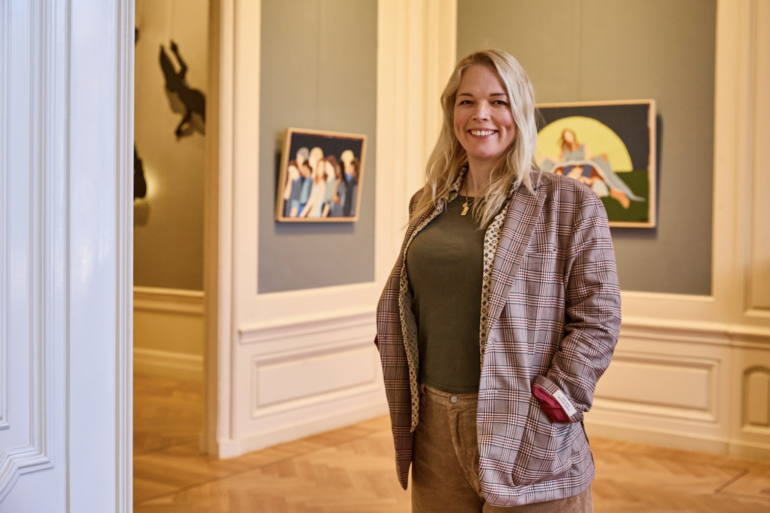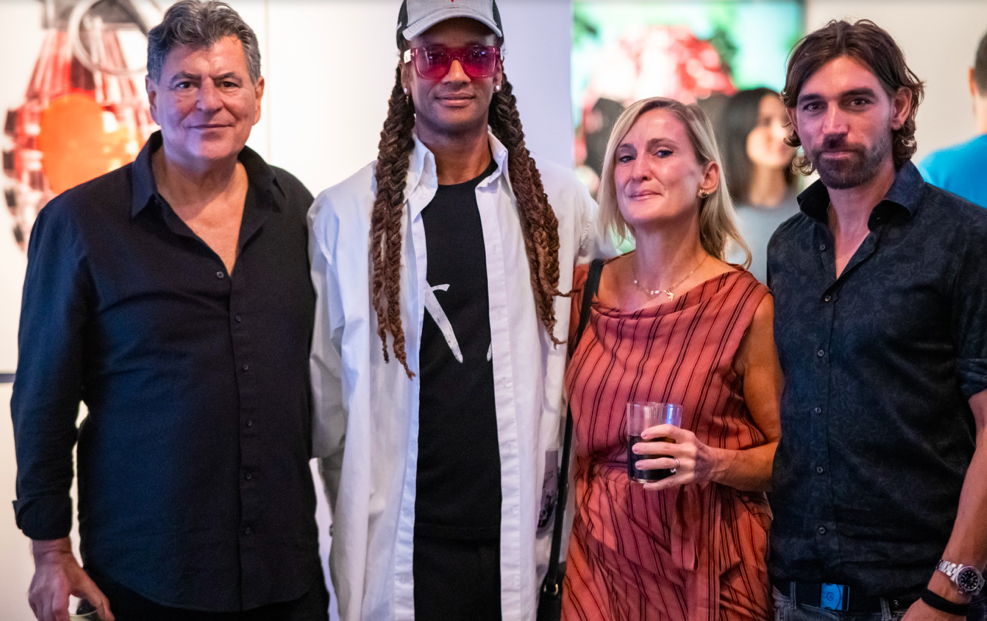Culturalee spoke to artist Thecla Schaeffer about her new exhibition at de Vrije Academie in Amsterdam’s historic canal district. The exhibition CATTLE (MOTHERHOOD) is Schaeffer’s bold statement against the creeping regression in women’s rights, bodily autonomy and identities. Thecla Schaeffer’s artwork and social dialogue interrogates the societal expectations placed on mothers and asks bigger questions around female identity and the role and perception of women in society.
Her art revolves around themes such as womanhood, motherhood, vulnerability, exploitation, justice, strength, and freedom. A deeply personal expression of her own journey, but one that’s simultaneously evolved into a universal narrative, reflecting the experiences of women in our world.
Schaeffer is the former CMO for global brands G-Star and Tony’s Chocolonely, and her exhibition CATTLE (MOTHERHOOD) invites audiences to reflect on the systemic oppression of women through the specific prism of motherhood – while simultaneously celebrating female resilience and the unbreakable bond between mother and child. Among the early patrons of Thecla’s work is the designer, musician and cultural disruptor Pharrell Williams, who has added numerous works into his private collection.
Thecla Schaeffer ‘Under Mother’s Skirt’.
Your exhibition at de Vrije Academie in Amsterdam explores themes around motherhood, female identity, bodily autonomy, oppression and liberation. What was the starting point for the motivation, and why did you choose the title ‘CATTLE’?
The starting point was that I wanted to express my personal experiences as a woman, both in my personal and professional life, in a way that wouldn’t be debated. Somehow, when you express your feelings through words, one can always give a counter argument (or at least that was the reality of my life at that moment), but emotion expressed in a visual way, and through the body, almost like a choreography, can only be felt, not argued with. I used very bright colors as a way to brighten my own mood like color therapy, but also to create visuals that would attract at first, like pop-art, but that then would tell a deeper story upon further studying. I didn’t want people to look away from my emotions and stories, so I used these bright colors to kind of lure them in.
CATTLE refers to the way that a woman’s creative – or creating – powers are being tamed, both literally and metaphorically. It refers directly to the way that our bodily autonomy is being questioned and taken away, but also our creative powers when it comes to telling our stories through art. Knowing that even in modern galleries women only represent around 15% of artists, women’s stories are still not heard or seen and somehow (subconsciously?) omitted from the public eye.
The name CATTLE took on special meaning for me after a call with Pharrell Williams. I had been dissatisfied with my original name for the collection but found clarity when I shared a painting online titled CATTLE – depicting pregnant women on hands and knees. Pharrell called soon after, emphasizing the title’s power: striking, direct, and confrontational. His enthusiasm confirmed my choice, making CATTLE the definitive name for the entire collection.
Thecla Schaeffer ‘It’s none of our business’ (S).
The women depicted in your artworks are strikingly heroic, evoking female heroines such as Boudicca or Joan of Arc. And you’ve used a golden circle around the women like some sort of Catholic halo. Were you inspired by religious byzantine iconography?
Yes absolutely, because I have always wondered how women are so deliberately omitted from religious stories, where they clearly have such an important role in the creation of mankind. It is the image of mother Mary and her son in all its forms that inspires me, because that is the one religious image that, to me, shows the role of the woman, the mother, as the source of life, and of morale and goodness.
And then it strikes me that religion creates rules for women to be obedient and submissive. Every ‘modern’ religion does that from Catholicism to Buddhism. I really cannot wrap my head around why men look down on women as being weak and less important, yet still put so much effort in taking away their power and autonomy. They must be scared of something? The only reason that comes to mind is: CATTLE, the taming and controlling of reproductive power.
I want to show a woman that despite that is strong and resilient. I also have a lot of work that has quite some anger in it and I’d love to build on that in the future. Because, even though women are so clearly oppressed, we are not allowed to be angry. So I want to find ways to express that anger, but in ways that people will look at it and not look away and disregard it as unattractive.
Thecla Schaeffer ‘Motherhood (A), Motherhood (B), Motherhood (C)’.
Who are the role models that you are looking to when you create your work, and are there any particular artists that you draw inspiration from?
I have a tendency to not look too much at other artists. When I worked at G-Star I once witnessed the CEO get real angry at a designer for having fashion magazines on her desk. He told her that those will pollute her brain and she would subconsciously start copying the looks and so create a less unique imagery for G-Star. He told her to look at architecture and go to galleries instead. That has always stuck with me.
I love looking at classic statues like those you have in the Louvre and the statues scattered around the city. There are a lot of female statues in Paris and also London. I love those of the women around Buckingham palace. I also like looking at pediments and tympanum, because of the power and iconography of it.
Thecla Schaeffer ‘Motherhood (A)’.
Your works are a mixture of collaged paintings and sculptures. How do you decide what medium to use?
I have recently painted more, because I have come to like the flexibility of it. I also had to overcome something, because I didn’t feel I had the skills for it. I don’t have any formal training. I was once mentored by another ‘real’ (white male, middle aged) artist who told me I need 10,000 hours of practice before I’m a good painter (Malcom Gladwell’s concept). This threw me off. But then I realised, after doing the math, that that is a patriarchal concept, because women, because of their other tasks like taking care of house and children, would take so much longer to reach mastery! It is kind of a ridiculous idea that I would have to lock myself up for 10+ years, before I would be taken seriously in telling my story. Before I would even be allowed to share what I have to share!
Then I decided to go technique-free, and that was hugely liberating. To be able to work any way I want. My art is about freedom and liberation and so are my techniques, free from rules!
Thecla Schaeffer ‘The Mother (CATTLE)’.
Less than 14% of living artists represented by galleries are women and over 85% of museum collections are dominated by white men. In 1989, the Guerrilla Girls questioned the patriarchy of the art world and famously found out that “Less than 5% of the artists in the Modern Art sections are women, but 85% of the nudes are female.” What is your mission with this exhibition, and do you plan to carry on flying the flag for women artists and challenging the patriarchy of art and advertising?
Yes, I would love to contribute my part and address this issue whenever I can. My imagery talks about women’s role in society and so it is a really important topic to me. I’d also love to explore further what I can do with this topic. I have been thinking about creating art under a man’s name to see if that would make any difference.
Thecla Schaeffer ‘It’s none of our business (L)’.
You had a very successful career as CMO of two big brands before becoming an artist. Did you find a lot of resistance from the patriarchy when you were on your way to reaching CMO level?
Yes a lot of the works are rooted in that frustration. I have also had great male allies on my journey, I have to give credit to the owner of G-Star here and to Pharrell who has been a great mentor, but I have also experienced crazy things in the way to the top. It’s a man’s game and you can be part of it if you – like the former CFO of Facebook, Sheryl Sandberg says – “lean in”, but it is much harder if you want to play by different rules. But to create really fair opportunities for women, the rules need to change.
Thecla Schaeffer ‘Shadow work – falling’.
A lot of artists started out at art school before going into advertising, and many advertising creatives are frustrated artists. Did you study at art school or are you completely self-taught?
I am self-taught. I have studied social and cultural psychology and the psychology of religion. The way that people create culture together and the way people are influenced by that culture has always intrigued me. That is how I ended up in advertising, because it is a lot about tapping into culture and creating it.
Photo credits all images: Lesley Weitjes



